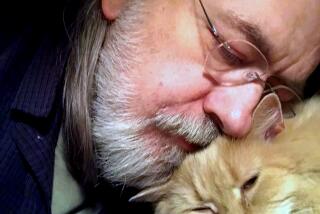Review: Ricky Jay’s obsession with Matthias Buchinger, an unbelievable 17th century showman
- Share via
Though the subject of Ricky Jay’s latest book is ostensibly Mattias Buchinger, the artist and showman who typically signed his work “born Without Hands or Feet in Germany June the 3 1674,” it is also the story of the author’s obsession with Buchinger’s life and work.
Jay is one of America’s most accomplished and erudite sleight-of-hand artists. He performs live and has acted in films by Paul Thomas Anderson, Gus Van Sant, Christopher Nolan and David Mamet — who also directed his three one-man shows — as well as in HBO’s “Deadwood.” His collection of decaying dice has been exhibited at the Museum of Jurassic Technology, and he has written before about unusual entertainers.
Buchinger, who stood 29 inches tall and described himself as “The Greatest German Living,” fits the bill. Not only did he lack hands and feet but also thighs and a good portion of his arms, one of which ended in a bulbous nub. One contemporary described Buchinger as “little more than the trunk of a man.”
Buchinger’s physical limitations, however, did not stop him from learning a number of skills, which he performed with admirable dexterity. He shot guns; he performed card tricks. The absence of feet did not inhibit his traveling across Europe to show off his abilities to earn a living. “This little Man performs such Wonders as have never been done by any; but Himself,” proclaimed the broadsides that he circulated before his performances, and though one can be forgiven for dismissing this as typical pitchman’s hyperbole, in Buchinger’s case it happened to be true.
His greatest achievement, and the reason for his continuing notoriety, was his skill with pen and ink. In addition to being able to draw portraits and scenes “to the life,” Buchinger was an eminently gifted calligrapher who could form letters forward, backward and upside down. He was also talented at micrographia, the art of writing passages that were, like him, infinitesimally small. How small? It was not uncommon for Buchinger to insert designs into his pieces that were an inch square and contained the entirety of the Lord’s Prayer.
For the better part of four decades, Jay has been doggedly tracking down the artist’s prints and drawings from private collectors, learning a great deal about the man along the way. The book serves as an appreciation of Buchinger’s artwork and the story of how so much of it ended up in Jay’s collection.
Along the way we meet dwarves, fire-eaters, eclectic collectors and keepers of curiosities, and learn about 18th century attitudes toward those born with deformities. For instance, early in his career, Buchinger was denied permission to perform at fairs and carnivals because of a widespread belief in “maternal imprinting,” the notion that the sight of a person with physical defects could shock a pregnant woman into giving birth to a baby with similar deformities.
Jay, who first wrote about Buchinger in his 1986 book “Learned Pigs & Fireproof Women: Unique, Eccentric and Amazing Entertainers,” is not your ordinary art historian. He has amassed an enormous collection of broadsides, posters and other ephemera from unusual performers from around the world. Moreover, he is uniquely attuned to the art of deception, something that served him well in his dealings with shrewd collectors.
“The Holy Grail” with regard to Buchinger to which Jay devotes an entire chapter is a stipple engraving of the performer. At first blush the engraving is similar to many of Buchinger’s portraits, which were a staple of his advertising, but upon closer examination “the curls of the hair within the wig are actually tiny letters beautifully positioned and rendered to demand your attention, and your admiration, and perhaps even your awe.”
It, like many of the images within this impeccably designed book by independent publisher Siglio, is truly awe-inspiring. It’s extremely difficult, if not impossible, to make out the letters without the aid of magnification. One can’t help but wonder how anyone working with quill and ink in the early 18th century was able to render writing so tiny yet so artfully, much less someone who didn’t have the full use of his hands and limbs.
Jay doesn’t have an answer for that. Despite surveying a panel of experts and considering the work of other micrographic artists, a fascinating chapter unto itself, all he can say for certain is that no account survives of Buchinger using a magnifying device — no small claim since his writing “tricks” were the highlight of his live act.
Ultimately, Jay argues, it doesn’t matter whether Buchinger used such a device or not. “Buchinger’s calligraphy is tangible in a way that his musicianship and dexterity are not.... You can marvel at it. You can see it, and even feel it, just like you might have that day three hundred years ago.”
The curious can get a closer look in person at the Metropolitan Museum of Art in New York, which is exhibiting “Wordplay: Matthias Buchinger’s Drawings From the Collection of Ricky Jay” until April 11.
Ruland is the author of the novel “Forest of Fortune.”
::
Matthias Buchinger: “The Greatest German Living”
Ricky Jay
Siglio: 160 pp., $39.95
More to Read
Sign up for our Book Club newsletter
Get the latest news, events and more from the Los Angeles Times Book Club, and help us get L.A. reading and talking.
You may occasionally receive promotional content from the Los Angeles Times.







